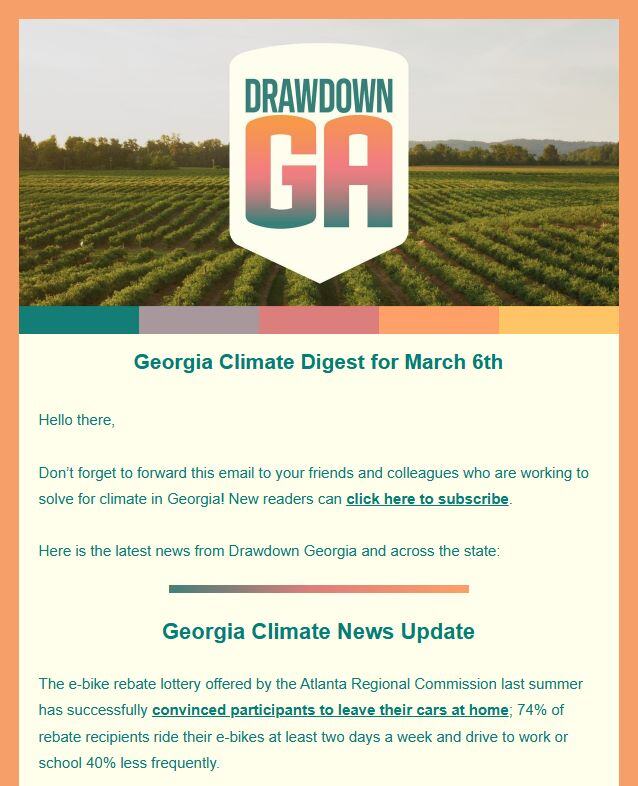The Benefits of Reduced Food Waste
Food waste refers to food that is produced but not eaten. It occurs for a variety of reasons, such as people purchasing more food than they need or customers rejecting bruised or misshapen produce. Food waste also occurs when food rots on farms or in the distribution process.
Every step of the food production and distribution process generates greenhouse gas emissions. Organic matter also produces methane, a potent greenhouse gas, when it decomposes in landfills.
Access Reduced Food Waste Resources from Drawdown Georgia
Market Readiness And Available Technology
Multiple interventions are required to reduce food waste both at the consumer and retail levels. Major interventions already identified include prevention, recovery, and recycling. Recent case studies by restaurants and hotels indicated that simple interventions would not only reduce food waste but also cut costs.
Georgia is home to several private and public food waste initiatives, such as:
- The Food Waste Warriors, a student-run composting program at STEAM school Lovin Elementary in Gwinnett County, collect leftover food at lunchtime for composting; the project was made possible by a grant from the World Wildlife Fund.
- Atlanta-based company Goodr has continued to develop technology and logistics to track an organization's surplus food from pickup to donation.
- Bagel Rescue is a nonprofit organization working to reduce food waste by partnering with 50 Atlanta-area bakeries to “rescue” unsold bagels. Each week, over 150 volunteers pick up and deliver bagels to food pantries and shelters across nine metro Atlanta counties. To date, the group has made more than 14,000 deliveries and donated over 2 million bagels.
- The Chick-fil-A Shared Table food donation program has diverted 25 million pounds of food waste from landfills and provided over 30 million meals to local communities in need. The program ensures that surplus food items, including chicken, fruit, biscuits, salads and more, were donated and transformed into meals for those affected by food insecurity.
A coordinated effort along the supply chain and policy changes are required to mitigate food waste.
Reduced Food Waste as a Climate Solution in Georgia
The Drawdown Georgia research team estimates that Georgia could reduce emissions by one megaton (Mt) of CO2e by reducing Georgia’s current food waste by about 12%.
What is the Carbon Emissions Reduction Potential by 2030?
Achievable reduction potential is derived by taking the technical reduction potential, outlined below, and developing a more realistic forecast that takes current rates of deployment, market constraints, and other barriers into consideration.
The Drawdown Georgia research team has calculated the achievable reduction potential for reducing food waste in Georgia to be 1.2 Mt of CO2e.
What Is the Upper Limit of Carbon Emissions Reduction Potential?
Technical reduction potential reflects the upper limit of emissions reductions for this solution without regard to the constraints that exist in the real world, such as economic or political considerations.
The Drawdown Georgia research team has calculated the technical reduction potential for reducing food waste in Georgia to be 4.3 Mt.
Challenges to Reducing Food Waste
A University of Georgia survey of more than 450 state residents (funded by Drawdown Georgia) provides insight into the types of food wasted at the household level. Two-thirds of the respondents were familiar with the issue of food waste, so a public awareness campaign would likely have limited impact. Twenty-five percent of respondents said they could not avoid any of the food waste in their household, and another 40% said they could only avoid a little.
On average, the survey respondents estimate their households are throwing away $34.95 worth of food per week (about $140/month). Not surprisingly, the most costly foods that are wasted are fruit, vegetables, meat, and fish.
How Reliable Is Our Estimate For This Drawdown Georgia Climate Solution?
According to USDA-ERS, about 63-67 million tons of food are wasted annually in the United States. Although no state-specific food loss data is available, we can use national data to calculate food waste in Georgia based on the state’s population.
For the state of Georgia, the estimated food waste is estimated to be about 2.03 million tons. We assumed that for every ton of food waste diverted, about 1.35 tons of CO2 could be reduced, depending on the interventions and based on the study by ReFED.
Cost Competitiveness
According to the ReFED organization, an investment of about $18 billion is required to reduce 13 million tons of food waste, which would yield a net economic value of $100 billion. However, costs depend on the ability to scale all three food waste reduction solutions: Prevention, recovery, and recycling.
Beyond Carbon Attributes
Reducing food waste decreases the food volume in landfills, improving environmental health by reducing methane air pollution. Around 56.7 million tonnes of food is wasted from farms to consumers in the United States, which entails using 16 million hectares of land, 3.9 million tonnes of fertilizers, and 17 billion cubic meters of irrigation.
Water quality and air quality are improved by less pesticide use. Public health is improved by increased food security and safety, especially when food that would otherwise be wasted is donated to those in need.
Potentially adverse effects include smaller profits for farmers as they may be encouraged to scale production to meet the reduced need. Overall, education needs to be spread to encourage changes in consumer and producer habits to lower food waste across all sectors.



